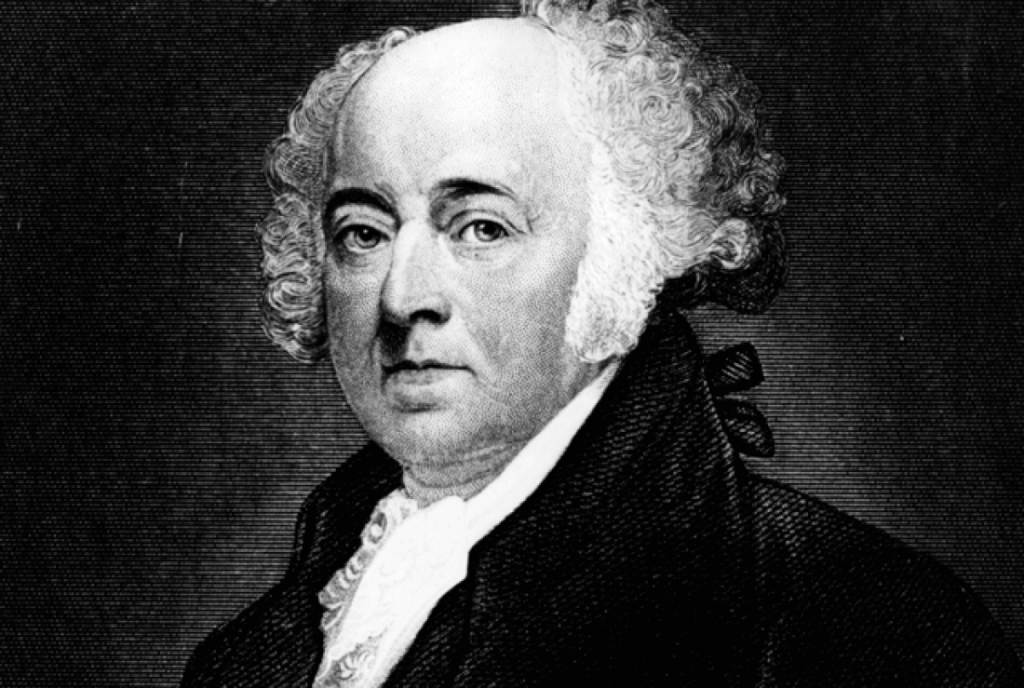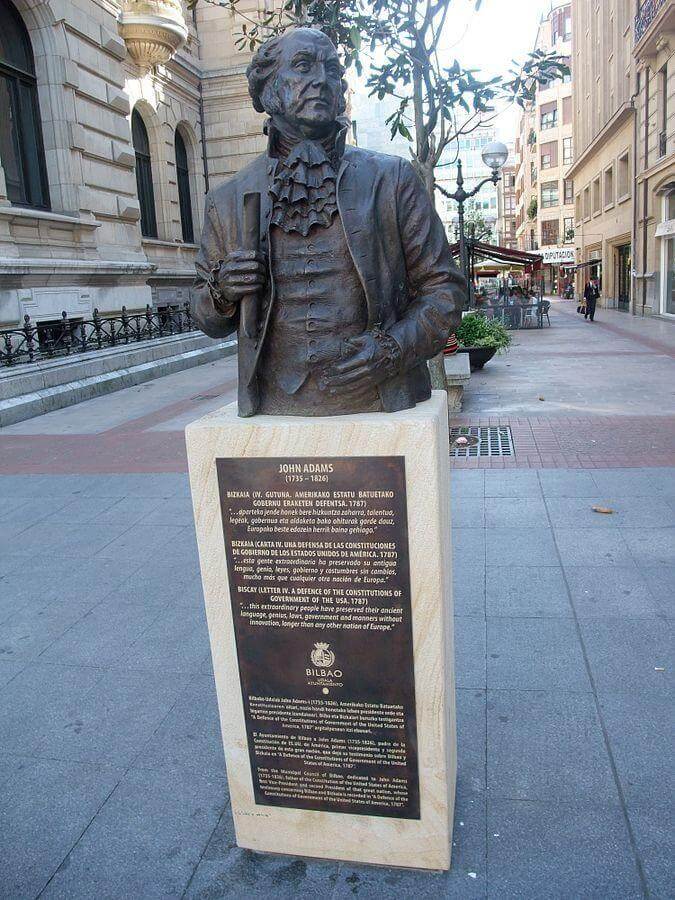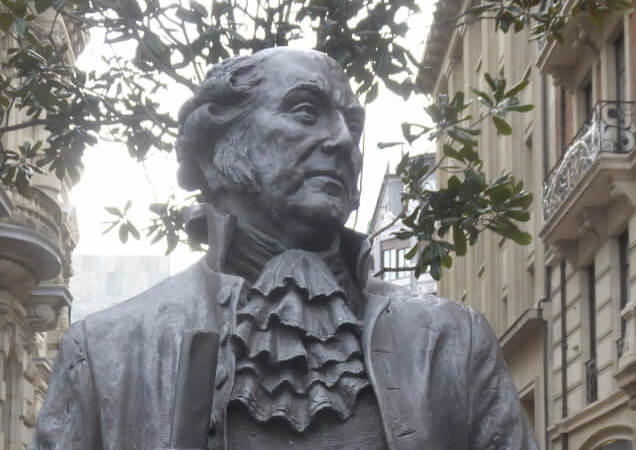This post contains affiliate links, meaning if you click through and make a purchase, I may earn a commission at no additional cost to you.
With it being President’s Day today, let me tell you about two US presidents who have visited the Basque Country.
The president with the most significant connection to the Basque Country was John Adams, the second president of the United States. His work brought him to the Basque Country before he was elected president.
Adams was sent to Paris at the end of 1779, in the middle of the American Revolutionary War, to work out an alliance with France.

Photo: Mental Floss
Along the Atlantic crossing, his ship encountered some setbacks and stormy weather that caused them to land in Galicia, just short of France. Adams decided to cross northern Spain into France on land rather than wait for the ship to be repaired.
John Adams’ Travels Through the Basque Country
This brought Adams through the Basque Country in January 1780, where he was able to learn about Biscayan governance, namely the fueros that dictated the rights and laws of Bizkaia.
Adams wrote very negatively in his diaries about the first leg of his journey through Spain, highlighting the poverty and suffering of the people.
But when he arrived in the Basque Country, his diaries change tone dramatically. He was impressed with the relative prosperity and economic bustle of Bilbao, feeling the land reminded him of Connecticut.
According to Aitor Delgado Tours of Bilbao, Adams spent a total of 8 days traveling through the Basque Country, passing through Espejo, Orduña, Luyando, Bilbao, St. Jean-de-Luz, and Bayonne.
You can read some excerpts from John Adams’ diaries during these travels here.
Fueros of Bizkaia Inspired U.S. Constitution
John Adams remembered his short stay in the Basque Country in his later 1787 publication, A Defence of the Constitutions of the Government of the United States of America, in which he included a section (Letter IV) about the Foral Democratic Republic of Biscay.
He cited Biscay (Bizkaia) as one of the top republic democracies of Europe, admiring their self-governance and independence within Spain.
In a 1981 speech, the late Secretary of State of Idaho Pete Cenarrusa listed some of the Biscayan principles that were incorporated into the U.S. Constitution based on John Adams’ research:
- That no person shall be treated inhumanely
- That a person’s home is his castle
- That no search shall be made of a person’s property without a search warrant
- That all shall be guaranteed a trial by a jury of peers
- That there be a separation of Church and State
This is all due to John Adams playing an important role in the eventual drafting of the U.S. Constitution.
However John Adams did find something in Biscayan politics for the new American country to avoid replicating: strict requirements of who is eligible to be elected to government office.
He found that only noblemen of ‘pure’ Basque blood, i.e. not mixed with Moors, Jews, new Christian converts, and penitentiaries of the Inquisition, could hold office. These noblemen also had to be natives and residents of the province, worth a certain amount of money, and have no business affiliations or history of working in trades.
Adams concluded: “Thus we see the people themselves have established by law a contracted aristocracy, under the appearance of a liberal democracy. Americans, beware!”
[For the record, I had to dig into the original text for that critical piece of information. All of the articles I read on the connection between John Adams and the Basque Country only highlighted the positive things Adams said of the Basques. Just something interesting to note–a reminder to think critically about everything you read on the internet!]
John Adams Statue in Bilbao
For Adams’ overall appreciation of the Biscayan fueros, a bust by sculptor Lourdes Umerez was erected in the Gran Via in Bilbao in 2011 to honor him, near the Bizkaia Province Parliament.

Photo: Bilbao: Arte en la Calle
The base of the statue holds an excerpt from his A Defence of the Constitutions of the Government of the United States of America about the Basques:
“… this extraordinary people have preserved their ancient language, genius, laws, government and manners, without innovation, longer than any other nation in Europe.”
What a nice sentiment.
I hope you found that information interesting on this President’s Day.
And remember at the beginning of this article I said there were two US Presidents who traveled through the Basque Country?
That’s because John Adams brought with him on the trip his 12-year-old son John Quincy Adams, who would later become the sixth president of the United States.
CONTINUE READING:
- A Unique Basque Festival: Tamborrada of San Sebastian
- How Napoleon’s Nephew Played a Vital Role in Understanding the Basque Language
- Paul Laxalt, Basque American Politician from Nevada, Dies at 96


My brother recommended I might like this blog. He was totally right.
This publish truly made my day. You cann’t consider just how so much time I had spent
for this info! Thanks!
Glad you enjoyed it! 🙂
The principal author of the US Constitution is James Madison, who also authored the Bill of Rights. John Adams was in England (serving as ambassador from the United States) from 1785 to 1788. The US Constitution was written in Philadelphia between May and September of 1787. Adams was probably referring to the various state constitutions under the Articles of Confederation, which was still in force until the new Constitution was put into effect in March of 1789.
This information is easy to verify. Sorry, he is not the “father of the US Constitution,” as is claimed by the municipal council of Bilbao. No disrespect to Basques, who share many things in common with Americans and Europeans regarding human rights and the ideals of democracy.
While James Madison is the “Father of the US Constitution” the THEORY of Constitutional government was laid predominantly (although obviously not exclusively) by John Adams. Not only was the Defence of Constitutions a major reference work for the delegates, but he had also authored the Massachusetts Constitution and had written many pamphlets in the pre-revolutionary and revolutionary periods formulating and laying out the legal theories which went onto become the basic assumptions future statesman worked from and worked with. While I might push back on the theory that John Adams DERIVED, for example, the separation of church and state or an Englishman’s home is his castle FROM the Basque people, he was certainly looking for evidence / proof throughout history FOR his theories and no doubt his experience in the Basque area contributed. And these arguments were very much present in Philadelphia. Beautiful statue and completely justified. (Shouldn’t take anything away from James Madison, of course, it’s not “either / or”)